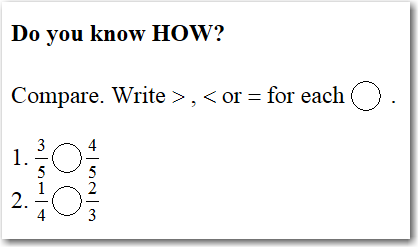Blanks often are visually displayed as underlined spaces,
although empty circles, squares, or other usages occur in
practice. Most of these can be represented by an menclose
element whose child is an mspace of the appropriate size.
However, other representations should not be ruled out.
1.3.1 Example 1

<ol>
<li>
<math xmlns="http://www.w3.org/1998/Math/MathML">
<mrow>
<mrow>
<mn> 667 </mn>
<mo> - </mo>
<mn> 358 </mn>
</mrow>
<mo> = </mo>
<menclose class="MathML-Blank" notation="bottom">
<mspace width="6em" height="2ex"/>
</menclose>
</mrow>
</math>
</li>
<li>
<math>
<mstack>
<mn> 515 </mn>
<msrow>
<mo> - </mo>
<mn> 472 </mn>
</msrow>
<msline/>
<mn class="MathML-Blank">     <!--no-break space--> </mn>
</mstack>
</math>
</li>
</ol>
Note that in the second example, mn was used. This is
important because we want the blank to be three digits wide,
and in an mstack or msrow, all elements are considered one digit
wide except for mn. See the MathML Recommendation
[MathML3] for more
information.
1.3.2 Example 2

<h4>Do you know <strong>HOW</strong>?</h4>
<p><span>Compare. Write </span>
<math xmlns="http://www.w3.org/1998/Math/MathML">
<mrow>
<mo> > </mo>
</mrow>
</math>
<span>, </span>
<math xmlns="http://www.w3.org/1998/Math/MathML">
<mrow>
<mo> < </mo>
</mrow>
</math>
<span> or </span>
<math xmlns="http://www.w3.org/1998/Math/MathML">
<mrow>
<mo> = </mo>
</mrow>
</math>
<span> for each </span>
<math xmlns="http://www.w3.org/1998/Math/MathML">
<mrow>
<menclose notation="circle">
<mspace width="1em" height="0.8em" depth="0.2em"/>
</menclose>
</mrow>
</math>
<span>.</span>
</p>
<ol>
<li>
<math xmlns="http://www.w3.org/1998/Math/MathML">
<mrow>
<mfrac>
<mn> 3 </mn>
<mn> 5 </mn>
</mfrac>
<menclose class="MathML-Blank" notation="circle">
<mspace width="1em" height="0.8em" depth="0.2em"/>
</menclose>
<mfrac>
<mn> 4 </mn>
<mn> 5 </mn>
</mfrac>
</mrow>
</math>
</li>
<li>
<math xmlns="http://www.w3.org/1998/Math/MathML">
<mrow>
<mfrac>
<mn> 1 </mn>
<mn> 4 </mn>
</mfrac>
<menclose class="MathML-Blank" notation="circle">
<mspace width="1em" height="0.8em" depth="0.2em"/>
</menclose>
<mfrac>
<mn> 2 </mn>
<mn> 3 </mn>
</mfrac>
</mrow>
</math>
</li>
</ol>
1.4 Rendering and Editing
Blanks on HTML Pages
NOTE: This section is in progress, it will discuss how this
would work in an HTML page that would use an editor that
allowed filling in the blank.
The markup proposed in this note is expected to be compatible
with HTML5/JavaScript environments in use in many contemporary
Web browsers. MathML is part of HTML5 and this note assumes
that math editors that take advantage of MathML support in
browsers will exist in the future (many prototypes already
exist). Other environments may choose to take a different
approach.
Web page designers should attempt to make a blank clearly
identifiable to readers so they know what to do to start
editing the formula. The primary idea is to make it possible
to move the focus to the blank; this can be done by the
addition of a JavaScript handler such as an onclick or
onkeypress event to the blank. When triggered, the script can
replace the blank by an entry form of some type. To facilitate
dealing with the result, the blank should be tagged with an id
attribute and result of the user editing should be part of a
form that is readily identifiable.
In many cases, an answer will be a simple number, identifier,
or linear expression and a text input box will suffice. In
this case, a standard <form> and
<input type="text"> could be
used.
In other cases, support for mathematical text entry is
required. The example below presupposes that there exists an
object editor with a JavaScript function 'mathEdit' which
causes a math editor to run which stores the answer as a
MathML expression in the value field of the input element of
the corresponding name. The math editor is assumed to be aware
of the MathML-Blank conventions described in this note.
A common technique hides in input elements the MathML content
so that it can be processed by a form submission and a server
can be reached with the formulae that the user has entered. We
recommend that the value of the id attribute be used as the
value of the name attribute of the corresponding hidden input
element. An example is shown below:
<form action="postAnswer" method="GET">
<p>Please express 0.375 as fraction.</p>
<p align="center">
<math displaystyle="true">
<mfrac>
<menclose notation="box"
id="numerator" class="MathML-Blank" title="click to edit"
onclick="return editor.mathEdit(this);">
<mspace width="1em" height="1em"/>
</menclose >
<menclose notation="box"
id="denominator" class="MathML-Blank" title="click to edit"
onclick="return editor.mathEdit(this);">
<mspace width="1em" height="1emx"/>
</menclose >
</mfrac>
</math>
</p>
<input type="hidden" name="numerator" value="..."/>
<input type="hidden" name="denominator" value="..."/>
<p align="right"><input type="submit" value="go"/></p>
<script type="text/javascript" src="blankEditor.js"></script>
</form>
Because a user may want to come back and edit an answer, it
is recommended that any entry should serve as the default
value should the user activate the “blank” again.
Aural rendering
Although specific uses of blanks may have specific ways of
being spoken, in general, the important thing to convey is
that the notation represents a blank, not the notation itself.
For example, if someone is suppose to fill one of ‘<’, ‘=’, or
‘>’, in a problem, it probably doesn't matter whether the
blank is an underline, is circled, or is just some white
space. With the use of the class attribute, it is easy for
aural renderers to say “blank” and skip the details of how the
blank is represented in an expression such as “5 _ 6”.


